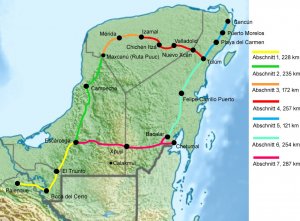*Maiden voyage of the Tren Maya on December 15, 2023*
The maiden voyage of the controversial Tren Maya takes place today, although a large part of the entire route is still unfinished. The first train of the mega-project will travel from Campeche to Cancún, whose station is also unfinished.
Far more controversial than this stage, which largely follows pre-existing tracks, is both the section running along the so-called Riviera Maya and, above all, the section cutting through the Calakmul Biosphere Reserve with the world heritage site of the same name and the second largest tropical forest in America.
Original message from 25.04.2023
Despite imposed construction stops, ignored environmental regulations and a budget that can no longer be met, let alone the completion date by the end of 2023, the controversial project is eating its way meter by meter through the fragile ecosystem of the Yucatecan forest.
The Tren Maya and the environment
While the Tren Maya is to run from the Mayan city of Palenque, via Campeche and Mérida to Izamal on an existing rail route, around 900 of the total 1500 km will have to be newly built. Particularly sensitive is the so-called Section 7 of the rail line between Escárcega in the west and Chetumal in the east, which cuts through the world-famous nature reserve near the Mayan ruins of Calakmul away from the existing National Road 186. Calakmul shares with Tikal in neighboring Guatemala the status of being both a World Cultural Heritage Site and a World Natural Heritage Site. Now it has become known that a 150-room hotel is to be built very close to Calakmul, although it had been agreed in the environmental regulations that a maximum of a 50-room hotel could be built here, also because of the scarce water resources. In addition, the prospective site is in the immediate vicinity of an important waterhole. Aguada Bonfil, as the waterhole is called, is of elementary importance for the region’s wildlife, including jaguars and ocelots. The owner of the hotel as well as the operator of the railroad line is the company known as Grupo México, which is essentially owned by the Mexican armed forces. These are also to benefit from a substantial part of the expected revenues from the tourism megaproject, which will also include a new airport in Tulúm.
Critics elsewhere along the rail line are also justifiably concerned that the construction project will cause irreparable environmental damage. For example, the rail line along the so-called Riviera Maya, from Cancún via Playa del Carmen, Tulúm and Bacalar to Chetumal, does not run parallel to Federal Highway 307, but kilometers inland above the Sac Actún underground cave and river system, the largest in the world after Ox Bel Ha. Geologists consider it a real danger that the vibrations of the rail cars thundering over the tracks could cause its limestone ceilings to break.
The Tren Maya and tourism
The Tren Maya also has no advantages for travelers who want to explore the Yucatán Peninsula on their own. After all, the train’s stations and stops are still kilometers away from the attraction that gives the train its name, and little-visited Mayan towns, for example on the Ruta Puuc or along Mex 186, as well as cenotes and old haciendas, remain out of reach of rail travelers.
Instead, even more tourists than before are to be lured to the major centers of Cancún, Playa del Carmen and Chichén Itzá, places that already suffer significantly from overtourism.
The Tren Maya and the Maya
In large parts of Mexico’s southeast, there is a perception of being economically isolated and at a disadvantage compared to the north. In fact, the construction of the Tren Maya is creating employment and income opportunities that did not exist before. Nevertheless, it would be an illusion to believe that the billions flowing into the rail project will benefit the indigenous population. Rather, expropriations are occurring along the rail line as rights of way are built, while the villages and small farmers of the peninsula fear for access to drinking water and fear the destruction of the forest’s natural resources.
The Tren Maya and the bigger picture
Der Tren Maya ist nur ein Teil eines weitaus größeren Infrastrukturprojektes, des so genannten Corredor Transístmico (Interozeanischer Korridor), der den Isthmus von Tehuantepec zur Konkurrenz für den Panamakanal ausbauen soll. Dies geschieht durch den Ausbau von Schienen, einer parallel verlaufenden Autobahn, Häfen und die Ausweisung von Sonderwirtschaftszonen, Industrieparks der Automobilindustrie und Petrochemie sowie so genannter Maquiladoras (“Lohnveredelungs”-Betriebe, in denen Produkte für den Export montiert werden).

